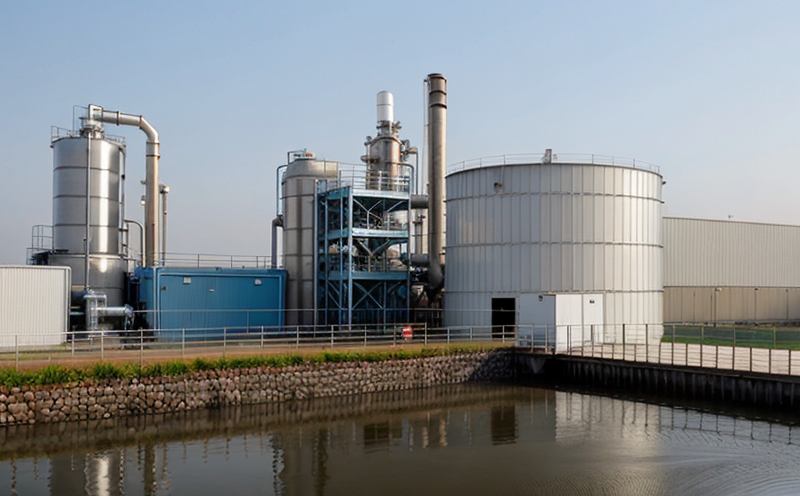ASTM D4839 Total Organic Carbon TOC Testing
The ASTM D4839 standard provides a method to measure total organic carbon (TOC) in aqueous samples. This test is crucial for industrial water and wastewater management, ensuring compliance with environmental regulations and optimizing process performance within manufacturing facilities.
Total Organic Carbon refers to the amount of carbon present in an aqueous sample that can be converted to CO2 upon oxidation. The ASTM D4839 method uses a high-temperature combustion technique where the TOC is oxidized in an oxygen-rich environment, and the resulting CO2 is measured by infrared detection.
Industrial manufacturing facilities often produce large volumes of wastewater as part of their production processes. Ensuring that these waters meet stringent TOC limits not only helps to comply with environmental regulations but also enhances water reuse capabilities within the facility. This test ensures that the quality of the treated water is optimal for reprocessing or discharge.
For facilities adhering to ISO 14001 and other environmental standards, ASTM D4839 TOC testing provides a reliable method to monitor process efficiency and environmental impact. The results can inform decisions on optimizing water treatment processes, reducing energy consumption, and minimizing carbon footprints.
The test is performed using specialized equipment such as a combustion analyzer. Specimen preparation involves filtering the sample to remove particulates and then transferring it into a combustion vial for analysis. Once prepared, the vials are inserted into the combustion furnace where they undergo high-temperature oxidation.
ASTM D4839 TOC testing is essential in industries such as pharmaceuticals, electronics, and food processing, where water quality directly impacts product purity and safety. Compliance with this standard ensures that manufacturing processes remain sustainable and efficient.
The ASTM D4839 method has been widely accepted due to its accuracy and reliability. It provides consistent results across different laboratories, making it a preferred choice for regulatory compliance and internal process control.
By adhering to this standard, industrial facilities can ensure that their water treatment processes are effective and efficient. This not only helps in meeting environmental regulations but also contributes to the overall sustainability of the facility.
Applied Standards
The ASTM D4839 standard is widely recognized for its accuracy and reliability in measuring total organic carbon. It is applicable across various sectors, including industrial manufacturing, water treatment facilities, and environmental monitoring.
- ASTM D4839-18: This version of the ASTM D4839 standard provides updated procedures for the combustion method to measure TOC in water. It ensures that laboratories are using the most current techniques and equipment, which is crucial for maintaining high standards.
- ISO 6878:2015: This international standard complements ASTM D4839 by providing a framework for the measurement of TOC in water. It ensures that laboratories are adhering to global best practices, enhancing consistency and reliability across different regions.
- EN 16576:2018: This European standard specifies requirements for measuring TOC in drinking water. While it is not directly applicable to industrial wastewater, it provides a benchmark for the accuracy of TOC measurements used in industrial settings.
The use of these standards ensures that industrial facilities are meeting international benchmarks and maintaining high-quality water treatment processes.
Environmental and Sustainability Contributions
ASTM D4839 TOC testing plays a significant role in environmental sustainability. By ensuring that industrial wastewater meets stringent TOC limits, the test helps reduce the carbon footprint of manufacturing facilities.
- Emission Reduction: Lowering TOC levels in wastewater reduces the amount of CO2 released into the environment during treatment and discharge processes.
- Resource Efficiency: Effective TOC testing helps industrial facilities optimize their water reuse systems, conserving valuable resources.
- Regulatory Compliance: Adhering to ASTM D4839 ensures compliance with environmental regulations, which is essential for maintaining a sustainable business model.
The test also supports the circular economy by promoting water reuse and recycling within industrial processes. This not only reduces the need for fresh water supplies but also minimizes waste generation.
Use Cases and Application Examples
ASTM D4839 TOC testing is particularly relevant in industries where water quality directly impacts product purity. For instance, pharmaceutical companies use this test to ensure that their wastewater does not contain harmful organic compounds that could affect the stability or efficacy of medications.
In electronics manufacturing, ensuring low TOC levels in water used for cleaning and rinsing processes is critical to prevent contamination of sensitive components. This can lead to improved product quality and reduced warranty claims.
Similarly, food processing facilities use ASTM D4839 TOC testing to monitor the purity of water used in production lines. High TOC levels could indicate the presence of contaminants that might affect the taste or safety of the final products.
The test is also beneficial for industrial wastewater treatment plants. By regularly measuring TOC, these facilities can optimize their treatment processes and ensure that treated water meets discharge limits set by regulatory bodies.
Furthermore, ASTM D4839 TOC testing supports sustainability initiatives within manufacturing plants by providing insights into process efficiency. This helps in identifying areas where improvements can be made to reduce energy consumption and operational costs.





